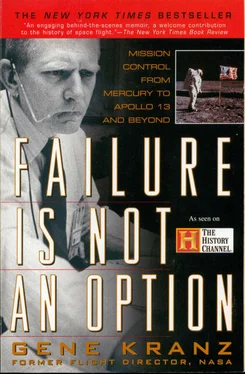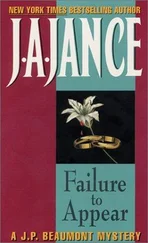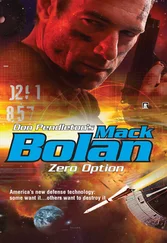Bob Bender, my editor at Simon &Schuster, believed in the book from the very start and his editorial work helped to make it what it is today.
There were, remarkably, few disagreements among interviewees concerning events, actions, and principals described in this book. On a few occasions while I was using the MCC voice tapes it was difficult for me to identify the controller or crewman involved in the action. When this happened, I used a combination of the MCC access lists, control room photos, and video tapes, if they were available, to determine the individuals involved. The portrayal of events on the final shift between John Hodge and Chris Kraft preceding the Apollo 1 fire (Chapter 10) and the specific crewmen involved in the final Apollo 11 mission simulation (Chapter 15) represents my best judgment about these events and individuals.
The NASA history series, particularly the books This New Ocean (Project Mercury), On the Shoulders of Titans (Project Gemini), Chariots of Apolloi (Project Apollo), and Stages of Saturn (Saturn rocket development), were invaluable references in developing the chronology in the book. I recommend them to my readers.
There is no doubt that although four decades have softened many of the emotions, we are still a brotherhood.
Any errors in telling this story are solely mine.
The one constant in the thirty-four years of my career in NASA was the consistent quality of our people, their dedication, and their willingness to do everything ever asked of them.
Three great leaders directed Flight Operations at the Manned Spacecraft Center in Houston. Chris Kraft, Sig Sjoberg, and Bill Tindall gave us our assignments, and when the chips were down trusted us to get it done. The four divisions under their direction were the Mission Planning and Analysis Division, led by John Mayer and Carl Huss; the Landing and Recovery Division, led by Jerry Hammack and Pete Armitage; the Flight Support Division, led by Lynwood Dunseith; and my Flight Control Division.
Rod Rose filled many roles in Flight Operations. He was the principal engineer integrating the myriad elements of the telemetry, voice, and trajectory data flow and processing.
Each of these divisions and key individuals, along with many others in the Manned Spacecraft Center, played a major role in the success of our early space ventures. My story is about only one of these great manned spaceflight teams.
The 400 members of the Flight Control Division staffed many of the Mission Control Center’s real-time decision positions. I was able to perform my duties as flight director because of a superb division staff who stepped in and ran the division when I was in training or working a mission. I would like to acknowledge the following individuals on the Flight Control Division staff: assistant for operations, Joe Roach; assistant for systems, Mel Brooks; chief of flight directors, Glynn Lunney; MSFC booster engineer office chief, Scott Hamner; technical assistant, Chuck Beers; business manager, Harold Miller; administration officer, Cecil Dorsey, and his assistant, Joyce Gaddy.
Lois Ransdell, “Pink Flight,” was my boss secretary and was ably supported by the division office secretaries: Suzanne Miller, flight directors; Carole Helms, booster engineers; Betty Defferari, business office.
The division had seven branches that corresponded to the technical specialties in Mission Control. The branch chiefs and their deputies worked as controllers while also leading the branch-level organizations. They selected and trained the new controllers in their basic skills, integrated the mission plans and documentation, and supported the spacecraft design. During simulations, they certified their controllers as ready for mission support. The branch chiefs and deputies were Charlie Harlan and Chuck Lewis—Flight Control Operations Branch; Jerry Bostick and Phil Shaffer—Flight Dynamics Branch; Carl Shelley and Gordon Ferguson—Simulation Branch; Richard Hoover and Lou DeLuca—Requirements Branch; Arnie Aldrich, Neil Hutchinson, and Rod Loe—CSM Systems Branch; Jim Hannigan, Don Puddy, and Bob Carlton—LM Systems Branch; Jim Saultz and Gerry Griffith—Experiment Systems Branch.
The branch secretaries also worked in Mission Control, and their work hours and life were as harried as that of the controllers. They were Sue Erwin, Ada Moon, Lucille Booth, Geraldine Taylor, Pat Garza, Maureen Bowen, Dorothy Hamilton, Kathy Spencer, and Elizabeth Pieberhofer.
The section chiefs led groups of five to seven controllers developing the spacecraft handbooks, procedures, and mission rules. They called the cadence, roused their controllers during the long and frustrating hours, and listened to their gripes. The section chiefs were Bill Platt, Ed Fendell, Perry Ealick, Bill Molnar, John Llewellyn, Ed Pavelka, Charlie Parker, Dick Koos, Jay Honeycutt, Lyle White, George Pettit, Charlie Dumis, John Aaron, Buck Willoughby, Gary Coen, John Wegener, Merlin Merritt, Bruce Walton, Harold Loden, Bill Peters, Ted White, Burt Sharpe, and Merrill Lowe.
Several of the section secretaries directly supported us in Mission Control. Among them were Jo Corey, Connie Turner, Sandra Lewis, and Donna Daughrity.
Great contractor teams supported the Flight Control Division. They kept the pipeline of information flowing so the controllers worked with correct and timely design and test data. “Learning by doing” worked because of the network of design engineers cultivated by these lead engineers: Bill “Blaster” Blair—North American; Charles Whitmore—Grumman; Stuart (Stu) Davis—Philco; Bill Harris and Ron Tunnicliff—McDonnell; Richard Freund—AC Electronics; Myron Hayes—IBM; Ron Bradford—Bendix; Jim Elrod—Lockheed; Fred Kuene and Lee Wible—Hamilton Standard.
To the rest of you in the ranks, you are in my heart.
APPENDIX
Foundations of Mission Control
To instill within ourselves these qualities essential for professional excellence:
DisciplineBeing able to follow as well as lead, knowing that we must master ourselves before we can master our task.
CompetenceThere being no substitute for total preparation and complete dedication, for space will not tolerate the careless or indifferent.
ConfidenceBelieving in ourselves as well as others, knowing that we must master fear and hesitation before we can succeed.
ResponsibilityRealizing that it cannot be shifted to others, for it belongs to each of us; we must answer for what we do, or fail to do.
ToughnessTaking a stand when we must; to try again, and again, even if it means following a more difficult path.
TeamworkRespecting and utilizing the ability of others, realizing that we work toward a common goal, for success depends on the efforts of all.
To always be aware that suddenly and unexpectedly we may find ourselves in a role where our performance has ultimate consequences.
To recognize that the greatest error is not to have tried and failed, but that in trying, we did not give it our best effort.
Abort- A time-critical termination of an event
AFB- Air Force base
AFD- assistant flight director—MCC
ALSEP- Apollo lunar surface experiment package
AOS- acquisition of signal
ATDA- augmented target docking adapter (used as a Gemini rendezvous target)
CapCom— capsule communicator
Cape— Cape Canaveral
CDR— commander—senior astronaut on Apollo mission
Читать дальше












